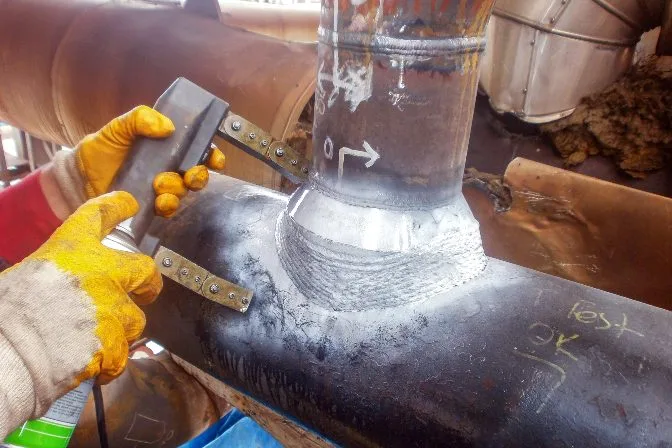Comprehensive Overview to Tank Welding Inspection for Security and High quality
Comprehensive Overview to Tank Welding Inspection for Security and High quality
Blog Article
The Essential Role of Container Welding Assessment in Ensuring Structural Honesty and Security Conformity in Industrial Applications
In the world of industrial applications, storage tank welding inspection emerges as an essential component in securing architectural integrity and ensuring conformity with safety laws. Using a mix of strategies such as visual assessments and progressed testing approaches, these inspections offer to recognize and alleviate prospective flaws before they escalate right into significant hazards.
Significance of Tank Welding Evaluation

Making certain compliance with market standards and regulations is another considerable element of tank welding assessment. Governing bodies mandate rigorous guidelines for the building and construction and maintenance of tank, and detailed examinations help organizations stick to these demands. Non-compliance can result in extreme penalties, consisting of penalties and shutdowns, further highlighting the demand for rigorous evaluation protocols.
In addition, storage tank welding assessment plays an essential function in preserving functional performance. In summary, the value of tank welding assessment exists in its capacity to guard public health and wellness, shield the setting, and ensure compliance with governing frameworks.
Key Assessment Techniques
Efficient storage tank welding examination counts on a selection of vital methods that make sure extensive assessment of weld high quality and architectural stability. Among the most prevalent techniques are visual assessment, ultrasonic screening, radiographic screening, and magnetic fragment testing - Tank Welding Inspection. Each approach provides unique advantages in assessing different aspects of the weld
Visual inspection functions as the very first line of protection, allowing assessors to determine surface flaws, irregularities, or incongruities in the weld grain. Ultrasonic testing uses high-frequency acoustic waves to detect interior defects, such as cracks or gaps, supplying an extensive analysis of weld honesty. This approach is particularly reliable in detecting issues that may not show up externally.
Radiographic screening makes use of X-rays or gamma rays to create photos of the welds, exposing internal suspensions and giving a long-term record for future recommendation. This technique is highly effective for crucial applications where the threat of failure must be lessened.
Finally, magnetic fragment testing is employed to recognize surface area and near-surface issues in ferromagnetic products. By applying electromagnetic fields and great iron fragments, examiners can identify discontinuities that may endanger the architectural integrity of the storage tank. Together, these strategies create a durable structure for ensuring top notch welds in industrial applications.
Compliance With Safety Requirements

Routine assessments play a pivotal function in making sure conformity by identifying prospective failures or deviations from prescribed criteria. Assessors are trained to assess weld top quality, validate product specifications, and evaluate the overall architectural honesty of containers. Their know-how is important in making certain that welding procedures meet the needed safety criteria.
In addition, conformity with safety criteria not only secures employees but likewise safeguards the setting from prospective hazards such as leakages or devastating failings. Organizations that prioritize safety compliance are much better positioned to reduce threats, improve functional effectiveness, and cultivate a society of safety and security within their labor force. In recap, maintaining strenuous compliance with security standards is essential for the effective address operation of storage tank welding activities in industrial setups.
Benefits of Regular Evaluations
Regular inspections are indispensable to keeping the architectural stability and safety and security of bonded containers. These examinations provide an organized approach to determining potential problems or weaknesses in the welds, making sure that any type of problems are attended to prior to they intensify into considerable failures. By carrying out regular evaluations, companies can spot deterioration, fatigue, and various other types of degeneration that may jeopardize storage tank performance.
Furthermore, constant evaluations add to conformity with sector policies and standards. Following these standards not only mitigates lawful dangers but also boosts the company's reputation for security and integrity. Routine assessments foster a proactive safety culture, motivating employees to acknowledge and focus on the value of equipment integrity.

Situation Research Studies and Real-World Applications
Situation studies and real-world applications show the tangible influence of efficient container welding assessment methods. Complying with the implementation of rigorous welding examination procedures, including aesthetic and ultrasonic screening, the center determined crucial problems in weld seams that might have led to catastrophic failings.
Similarly, a water therapy plant executed a detailed examination program for its storage tank welding procedures - Tank Welding Inspection. By integrating non-destructive screening methods, the plant had the ability to spot early signs of rust and tiredness in weld joints. This timely treatment prolonged the life expectancy of the storage tanks and made sure compliance with security guidelines, therefore guarding public wellness
These study emphasize the relevance of routine and organized storage tank welding assessments. By focusing on these techniques, markets can minimize threats, boost architectural integrity, and make sure compliance with security criteria, eventually leading to improved functional performance and minimized obligations.

Conclusion
In conclusion, storage tank welding evaluation is an essential component of maintaining architectural stability and safety in commercial applications. Utilizing numerous assessment methods makes certain early detection of prospective flaws, therefore protecting against catastrophic failures. Adherence to safety standards further improves functional reliability and compliance with regulative requirements. Ultimately, routine examinations not only protect public health and the environment yet also add to the longevity and performance of critical properties, underscoring the crucial role of this technique in commercial procedures.
Report this page